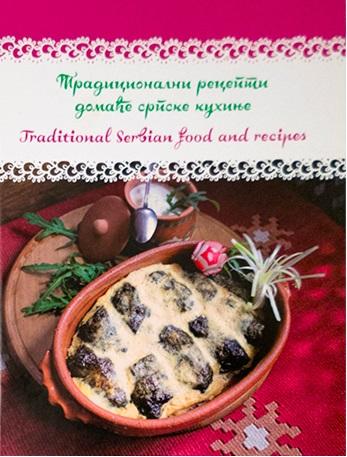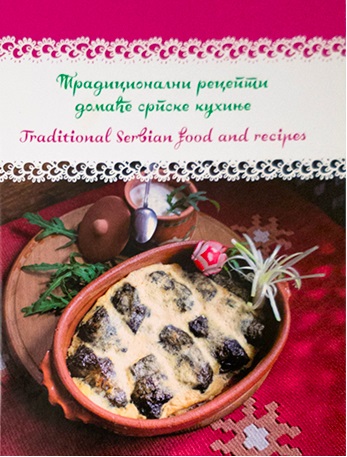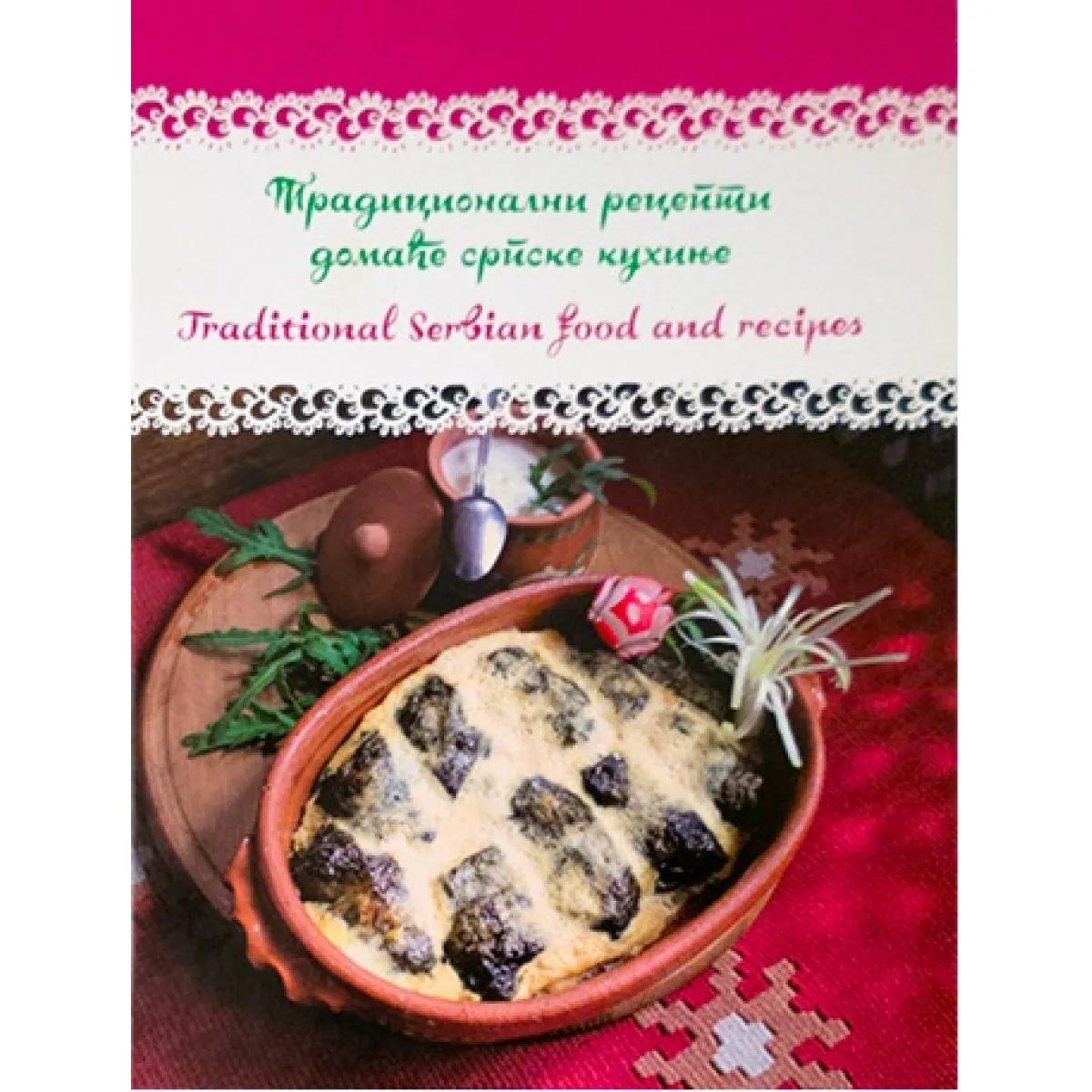Iz predgovora
“Knjiga Tradicionalni recepti domaće srpske kuhinje predstavlja riznicu podataka koji ne govore samo o sastavu jela, već i o jednom načinu života koji polako, ali nepovratno nestaje. O načinu života kad se kuvalo za porodicu, kad je postojalo vreme za dugu pripremu jela, kad je cela porodica sedela za stolom i kad se nije znalo za zamrznute ili podgrejane obroke. Listajući knjigu, čitajući recepte skoro da ćete osetiti miris ovih sveže pripremljenih i ukusnih jela, a nadam se da ćete poželeti da sebi i sebi dragim ljudima neka od tih jela i spremite, i tako zajedno sa Miodragom Ilićem učinite korak ka očuvanju domaće kulinarske tradicije od zaborava.”,
prof dr Slađana Šobajić.
Sadržaj
Reč autora, 11
Predgovor, 15
Ishrana u Srbiji kroz istoriju, 23
Istorijat ishrane, 31
Hleb, 35
Beskvasni hleb, 37
Meso, 39
Kuvano žito i brašno, 43
Ribe, rakovi, puževi, 45
Povrće, 47
Običaji, 49
Porodična slava, 53
Slavski kolač, 57
Slavsko žito, 59
Božićna česnica, 61
Božićna česnica, 63
Sofra, 65
Recepti domaće kuhinje, 69
Pre nego što počnete.., 75
Vojvodina, 83
Recepti iz Vojvodine, 85
Supa, 89
Ajnpren čorba, 91
Kitnkez, 93
Pekmez od kajsija, 95
Ćušpajz, 97
Koh, 99
Nasuvo s krompirom, 101
Paprikaš, 103
Gulaš, 105
Perkelt, 107
Reform torta, 109
London štangle, 111
Medenjaci, 113
Štrudla s makom, 115
Pogačice sa čvarcima, 117
Šnenokle, 119
Princes krofne, 121
Pihtije, 123
Ajmokac, 127
Damen kapric, 129
Doboš torta, 131
Klecenbrot, 133
Lenja pita sa jabukama, 135
Knedle sa šljivama, 137
Knedle sa sirom, 139
Šufnudle, 141
Rezanci sa makom, 143
Vanilice, 145
Mačvanski listići, 147
Krofne, 149
Cipovka, 151
Istočna Srbija, 155
Recepti iz istočne Srbije, 157
Pasulj, 161
Pita, 163
Plnjen piper, 165
Zeljanik, 167
Sukani tikvenik, 169
Čorba, 171
Čomlek, 173
Tepsija, 177
Podvarak, 179
Ćovtetija, 181
Kavarma, 183 Belmuž, 185
Sukana pita sa kiselim kupusom i sirom, 187
Kisela banica, 189
Varivo od boba, 191
Starinska čorba od lobode, 193
Gužvice, 195
Varivo od šumskih pečurki, 197
Moruznica, 199
Posna torta s belim vinom, 201 Recelj, 203
Mlečnica, 205
Slatko od šljiva, 207
Južna Srbija, 209
Recepti iz južne Srbije, 211
Prpeć, 213
Sečenica, 217
Samsa, 219
Trljanica, 221
Ljutenica, 223
Pinđur, 225
Ajvar, 227
Klucana salata, 229
Kasapski đuveč 231
Gravče na tavče, 233
Sarmice od zelja, 235
Zapadna Srbija, 237
Recepti iz zapadne Srbije, 239
Slatki sutlijaš, 241
Šljivopita, 243
Halva, 245
Kadaif, 247
Baklava, 249
Gurabije, 251
Mantije sa sirom, 253
Urmašice, 255
Kajmak 257
Burek, 259
Heljdopita, 261
Centralna Srbija, 263
Recepti iz centralne Srbije, 265
Projin hleb, 267
Punjene paprike, 269
Pogača, 271
Popara, 273
Cicvara, 275
Kupus kiseli, 277
Kiselo mleko, 279
Kačamak, 281
Sarma, 285
Uštipci, 287
Pita s kiselim jabukama, 289
Vanilice sa ljutom rakijom, 291
Pečenje, 293
Gibanica, 297
Vasina torta, 299
Kosovo n Metohnje 301
Recepti sa Kosova i Metohije, 303
Razlevnice, 305
Gruvanice, 309
Grožđuša, 311
Vaši omiljeni recepti, 312
Literatura, 319
Autorski tim, 321
Zahvalnost, 333
Pokrovitelj knjige: Privredna komora Srbije, 337
Recenzija, 341
Reč autora
Poštovani čitaoci,
Pred vama je knjiga o tradicionalnim receptima domaće kuhinje. Termin „srpski” iz punog naziva knjige Tradicionalni recepti domaće srpske kuhinje, geografska je odrednica, što znači da su u knjizi prezentovani recepti za koje postoje pouzdani dokazi da su bili pripremani krajem 19. i početkom 20. veka, odnosno pre Drugog svetskog rata, na teritoriji tadašnje države Srbije.
Potrudili smo se da vam u ovoj knjizi prikažemo kako najpopularnija tako i potpuno nepoznata jela, a sve kako bismo vam dočarali jedno prošlo vreme kada industrijalizacija, vizuelna prezentacija i marketing nisu imali presudni uticaj na kulturu ishrane.
Ovom knjigom ne želimo da postavljamo standarde i definišemo koji su „originalni” tradicionalni recepti, a koji to nisu. Po našem skromnom mišljenju, tako nešto ne postoji. Svaki od navedenih recepata je jednom neko izmislio i time je pokrenuo neprekidnu istoriju njegovog razvoja, sa svim promenama i nadogradnjama koje se podrazumevaju do današnjeg doba, a sigurni smo i u budućim vremenima. Prema našim analizama, ne postoji ni jedan jedini recept koji nije pretrpeo makar malu izmenu ili nadogradnju. Takođe, ne postoji nijedno mesto u Srbiji, niti ijedna kuća, porodica i domaćica, koji neće ljubomorno braniti kvalifikaciju: „Moj recept je jedini originalan, to o čemu vi pričate nije originalni recept!”
Ovo naše putovanje kroz gastronomiju prostora stare Srbije je, znamo, veoma kratko i svedeno. Za života svakog od nas nema dovoljno vremena ni prostora, gde bi se sve to moglo na valjan način opisati. Trebalo bi zaviriti u posebnost svakog regiona, svakog kraja, svakog mesta, svakog domaćinstva, svake domaćice i iskazati dužnu pažnju i poštovanje istoriji, kulturi i posebnostima svakog od njih.
Istraživanje i rad na ovoj knjizi trajali su nepunih godinu dana, a privedeni su kraju uz veliku pomoć saradnika i prijatelja ovog projekta. Posebnu zahvalnost svima iskazujem kompletnom listom na kraju ove knjige.
Za sve one koji žele da se na bilo koji način ubuduće bave ovom materijom, da sačuvaju deo tradicije od zaborava, moramo za kraj citirati reči dr Jovana Erdeljanovića iz uvoda u knjigu Srpska narodnajela i pića:
„Onima koji bi se prihvatili ovoga posla (očuvanja jela i pića od zaborava prim. aut.)- naročito preporučujem da tragaju za onim načinima u gotovljenju jela i pića, koji su vrlo prosti ili starinski, te su se ili već sasvim izgubili i samo ih možda pamte stariji ljudi ili se njima služe jedino pastiri, radnici, sirotinja i sl.”
Važna napomena svima koji požele da se oprobajuu kulinarskim veštinama pripremajući jela prema receptima iz oee knjte:
- Sastojci nisu mereni apotekarskom preciznošću!
- Sastojci koje smo mi koristili mogu se bitno razlikovati po kvalitetu, volumenu i težini od sastojaka kojima vi raspolažete!
- Isprobavajte, menjajte, prilšođavajte!
- Pronađite onaj odnos i onaj završni ukus i kvalitet koji vas ispunjava zadovoljstvom i srećom!
- Ova knjiga je napisana da vas mirisima i ukusima podseti na tradiciju, detinjstvo, rodni kraj, rodnu kuću... Da pronađete INSPIRACIJU u da UŽIVATE! Prijatno vam bilo!
Za početak čitanja, hvala vam od srca što ste kupili ovu knjigu i što nam pomažete da se jedan deo naše kulture sačuva od zaborava!
Miodrag Ilić
Beograd, oktobar 2017
Recenzija
NAŠA ZEMLjA vekovima je bila na meti osvajača, često pod okupacijom tuđinskih vladara i kultura, na raskršću puteva kojima su prolazili i trgovački karavani, pa je u amanet dobila neobičnu mešavinu starogrčke, vizantijske, istočnjačke, austrougarske, francuske i ruske gastronomske zaostavštine.
Prema šturim ali ipak dovoljnim podacima, koji su nam danas na raspolaganju, sa sigurnošću možemo da tvrdimo da srpska kuhinja seže u daleku prošlost. To nam daje mogućnost da razmišljamo o istoriji srpske gastronomije kao o kontinuiranom procesu, koji je na kraju dao rezultat zvani srpska nacionalna kuhinja.
Zbog toga možda i postoji toliko nedoumica i među profesionalcima, i među građanima, i među turistima šta je zapravo srpska kuhinja: da li ono što se svakodnevno priprema u domaćinstvima ili ono što je ispisano u receptima i štampano u raznim knjigama. Tako osmišljena, ona postaje temelj ugostiteljske i turističke ponude Srbije, svojevrstan brend, koji će moći da se promoviše.
Autor se potrudio da javnosti u ovoj knjizi predstavi sve rezultate istraživačkog rada. Svest da o ishrani srpskog naroda kroz istoriju ne posedujemo mnogo pisanog materijala predstavlja razlog više da se ova tema obrađuje postupno i temeljno.
O ovoj temi autor govori ne samo da bi uvidom u recepte jela naših predaka zadovoljio našu radoznalost i konačno ih zapisao i popisao, već i zbog toga da bi što više njih ponovo postalo deo naše svakodnevne ishrane i ponude restorana i hotela. Posle toliko godina neki specijaliteti ponovo će, nadam se, zamirisati u našim kuhinjama.
Uroš Urošević
Contents
Author's foreword, 10
Foreword, 14
Food culture in Serbia through history, 22
History of diet, 30
Bread, 34
Unleavened bread, 36
Meat, 38
Cooked grains and flour, 42
Fish, crayfish, snails, 44
Vegetables, 46
Customs, 48
Family slava, 52
Slavski kolač, 54
Slavsko žito, 58
Božićna česnica, 60
Božićna česnica, 62
Sofra, 64
Traditional food and recipes, 68
Before you start.., 74
Vojvodina, 82
Recipes from Vojvodina, 84
Supa, 88
Ajnpren čorba, 90
Kitnkez, 92
Pekmez od kajsija, 94
Ćušpajz, 96
Koh, 98
Nasuvo s krompirom, 100
Paprikaš, 102
Gulaš, 104
Perkelt, 106
Reform torta, 108
London štangle, 110
Medenjaci, 112
Štrudla s makom, 114
Pogačice sa čvarcima, 116
Šnenokle, 118
Princes krofhe, 120
Pihti]e, 122
Ajmokac, 126
Damen kapric, 128
Doboš torta, 130
Klecenbrot, 132
Lenja pita sa jabukama, 134
Knedle sa šljivama, 136
Knedle sa sirom, 138
Sufhudle, 140
Rezanci sa makom, 142
Vanilice, 144
Mačvanski listići, 146
Krofne, 148
Cipovka, 150
Eastern Serbia, 154
Recipes from Eastern Serbia, 156
Pasulj, 160
Pita, 162
Plnjen piper, 164
Zeljanik, 166
Sukani tikvenik, 168
Čorba, 170
Čomlek, 172
Đuveč, 174
Tepsija, 176
Podvarak, 178
Ćovtetija, 180
Kavarma, 182
Belmuž, 184
Sukana pita sa kiselim kupusom i sirom, 186
Kisela banica, 188
Varivo od boba, 190
Starinska čorba od lobode, 192
Gužvice, 194
Varivo od šumskih pečurki, 196
Moruznica, 198
Posna torta s belim vinom, 200
Recelj, 202;
Mlečnica, 204
Slatko od šljiva, 206
South Serbia, 208
Recipes from South Serbia, 210
Prpeć, 212
Sečenica, 216
Samsa, 218
Trljanica, 220
Ljutenica, 222
Pinđur, 224
Ajvar, 226
Klucana salata, 228
Kasapski đuveč, 230
Gravče na tavče 232
Sarmice od zelja, 234
Western Serbia, 236
Recipes from Western Serbia, 238
Slatki sutlijaš, 240
Šljivopita, 242
Halva, 244
Kadaif, 246
Bakava, 248
Gurabije, 250
Mantije sa sirom, 252
Urmašice, 254
Kajmak, 256
Burek, 258
Heljdopita, 260
Central Serbia, 262
Recipes from Central Serbia, 264
Projin hleb, 266
Punjene paprike, 268
Pogaca, 270; Popara, 272
Cicvara, 274
Kupus kiseli, 276
Kiselo mleko, 278
Kačamak, 280
Sarma, 284
Uštipci 286
Pita s kiselim jabukama, 288
Vanilice sa ljutom rakijom, 290
Pečenje 292
Gibanica, 296
Vasina torta, 298
Kosovo nad Metohija, 300
Recipes from Kosovo and Metohija, 302
Razlevnice, 304
Gruvanice, 308
Grožđuša, 310
Your favourite recipes, 312
References, 318
Team of authors, 320
Acknowledgement, 332
Benefactor of this book: Serbian Chamber of Commerce, 336
Author's foreword
Dear readers,
What you have in your hands is a book of traditional folk recipes. The term “Serbian” from the full tide of this book Traditional Serbian food and recipes is a geographic denominator, meaning that this book presents the recipes for which there is reliable evidence that they used to be prepared in late 19th and early 20th century, before the Second World War, at the territory of state of Serbia as defined at that time.
In this book we put in a lot of effort to present both the most popular and the completely forgotten dishes, in order to illuminate the time in the past when industrialization, visual presentation and marketing were not crucial for the culture of food.
This book does not have a goal to set standards and define the “original” traditional recipes vs. the others. According to our humble opinion, there is no such thing. Each of the listed recipes was once invented by someone, starting a continuous history of its development with all the modifications and additions to this very day, and I am sure that it will continue in the future. According to our analyses, there is not a single recipe that never experienced a small modification or addition. There is also no town in Serbia or any home, family and homemaker who will not jealously defend the qualification: “My recipe is the only original one, that thing you are talking about is not the original recipe!”
Our journey through gastronomy of region of Old Serbia is, we are aware, very short and condensed. In the lifetime of each of us there is not enough time or space to describe it all in a proper way. It would be necessary to acknowledge the specificities of each region, each district, each town, each household, each homemaker’s experience, showing due respect and care for history, culture and specific features of each of them.
Research and work on this book lasted for almost a year, and they were finalized with great help of our associates and friends of the project. I will specially acknowledge each of them in the complete list at the end of this book.
For all those who intend to be active in this field in any form, to save a part of tradition from oblivion, at the end I must cite the words of Dr Jovan Erdeljanović from the introduction to the book Serbian folk dishes and beverages.л
“To those who would take upon themselves this task,” (saving dishes and beverages from oblivion author’s remark) “my special recommendation is to look for those traditions in preparing dishes and beverages that are very simple or ancient, so they are either completely lost or maybe remembered only by the oldest persons, or used only by shepherds, manual workers, the poor etc.”
An important remark to all those who wish to test their culinary skills by preparing dishes according to the recipes from this book
- The ingredients were not measured with apothecary precision!
- Тhe ingredients we used may be significantly different in quality, volume and weight from the ingredients at your disposal!
- Try, change, adapt!
Find the ratio and the final taste and quality that fill you with pleasure and happiness!
The goal of this book is to use fragrances and flavors to remind you of tradition, childhood, and hometown, home where you were bom... To find INSPIRATION and to ENJOY! Cheers!
As you start reading, I send you my cordial gratitude for buying this book and supporting a part of our culture to be saved from oblivion!
Miodrag ILIĆ
Belgrade, October 2017.
From the foreword
Prof Dr Sladana Šobajić
TRADITION AND CUSTOMS play an important role in the cultural identification of each nation. Regardless whether these are written records or oral telling, the information on way of life in the past enables us to preserve authenticity and identity of communities closely connected by the same geographic origin, to preserve traditional knowledge and skills that may not be necessary any more but represent a part of historical heritage. The traditional food, as a product of the environment, natural resources, but also culture, history and way of life in a certain area, plays an important role in overall tradition of a nation. All nations, countries and ethnic communities have specific dietary habits that differ more or less significantly from the habits of other communities. They are transferred from one generation to the next, have an important role in the folklore and customs of certain regions for hundreds or even thousands of years, and contribute to overall cultural diversity.
Traditional dishes are also the first part of heritage encountered when you meet new cultures. I am a travel-loving person. I love to meet new regions, different ways of life, new towns, new people and, of course, new cuisines. Each country I visited was proud to show its most beautiful culturally-historical monuments, the most beautiful mountains, rivers and lakes, but this was always spiced up with characteristic traditional dishes and beverages, and their absence would make all impressions incomplete. Each of these more or less new and unusual dishes was accompanied by a special story of their origin, revealing a part of tradition, history and national pride of these countries. In Peru, while I enjoyed the acidic taste of ceviche, I learned that this dish of fish and seafood marinated in lemon juice may be up to 4000 years old, and that only the Peruvian ceviche is original as it was later introduced to other countries of Latin America. In Nepal we were daily offered dalbhat, a dish of rice, lentils and curry, which for the Nepalese is more than a meal...
Review
FOR CENTURIES our country was a target of conquerors, often under occupation of foreign rulers and cultures while trade caravans also passed through these crossroads, so their legacy is an unusual mixture of Ancient Greek, Byzantine, Oriental, AustroHungarian, French and Russian gastronomic heritage.
According to scarce but still sufficient data available for our presentday analysis, we can claim with high confidence that the Serbian cuisine has been reaching into the distant past. Therefore we are now able to envision the history of Serbian gastronomy as a continuous process that finally resulted in the Serbian national cuisine.
This may be the leading cause of so many headscratchers, among the professionals as well as among citizens and guest tourists, about the real nature of the Serbian cuisine: is it what is prepared in homes on daily basis, or what is written in recipes and printed in various books? Once defined, it becomes the foundation of restaurant and tourist offer of Serbia, a special promotable brand.
The author has put in a lot of effort to present the entire results of his research in form of a book. The awareness of scarcity of written material on diet of Serbian people through history is an additional reason to approach this subject gradually and in great detail.
The goal of the author is not just fo present the dishes made by our ancestors in order to satisfy our curiosity and to finally have them all written and listed in one place, but also to reintroduce as many of them as possible into the everyday diet and restaurant and hotel offer. I hope that after so many years some of these special delicacies will again spread their aromas through our kitchens.
Uroš Urošević




